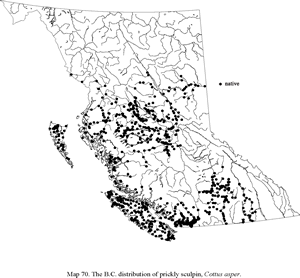Dorsal spines (total): 7 - 10; Dorsal soft rays (total): 18 - 23; Anal spines: 0; Anal soft rays: 15 - 19; Vertebrae: 34 - 39. Distinguished by a complete lateral line, a single pore at the tip of the chin, the presence of 15 to 19 anal rays, and well developed palatine teeth (Ref. 27547). Pectorals large and fan-shaped; caudal truncate or slightly rounded (Ref. 27547). Dark brown, olive or gray above and on sides, whitish yellow to white below; usually three dark irregular blotches or bars below soft dorsal; vague irregular dark mark on sides; fins (except anal) have dark bars, the first dorsal with a dark spot towards the rear (Ref. 27547). Both sexes show an orange band on the edge of the first dorsal fin at spawning time (Ref. 27547). The inland form is generally more densely prickled over a larger portion of the body while the coastal form shows a reduced number of prickles (Ref. 28211).
Source: FishBase. Page, L.M. and B.M. Burr 1991 A field guide to freshwater fishes of North America north of Mexico. Houghton Mifflin Company, Boston. 432 p.
